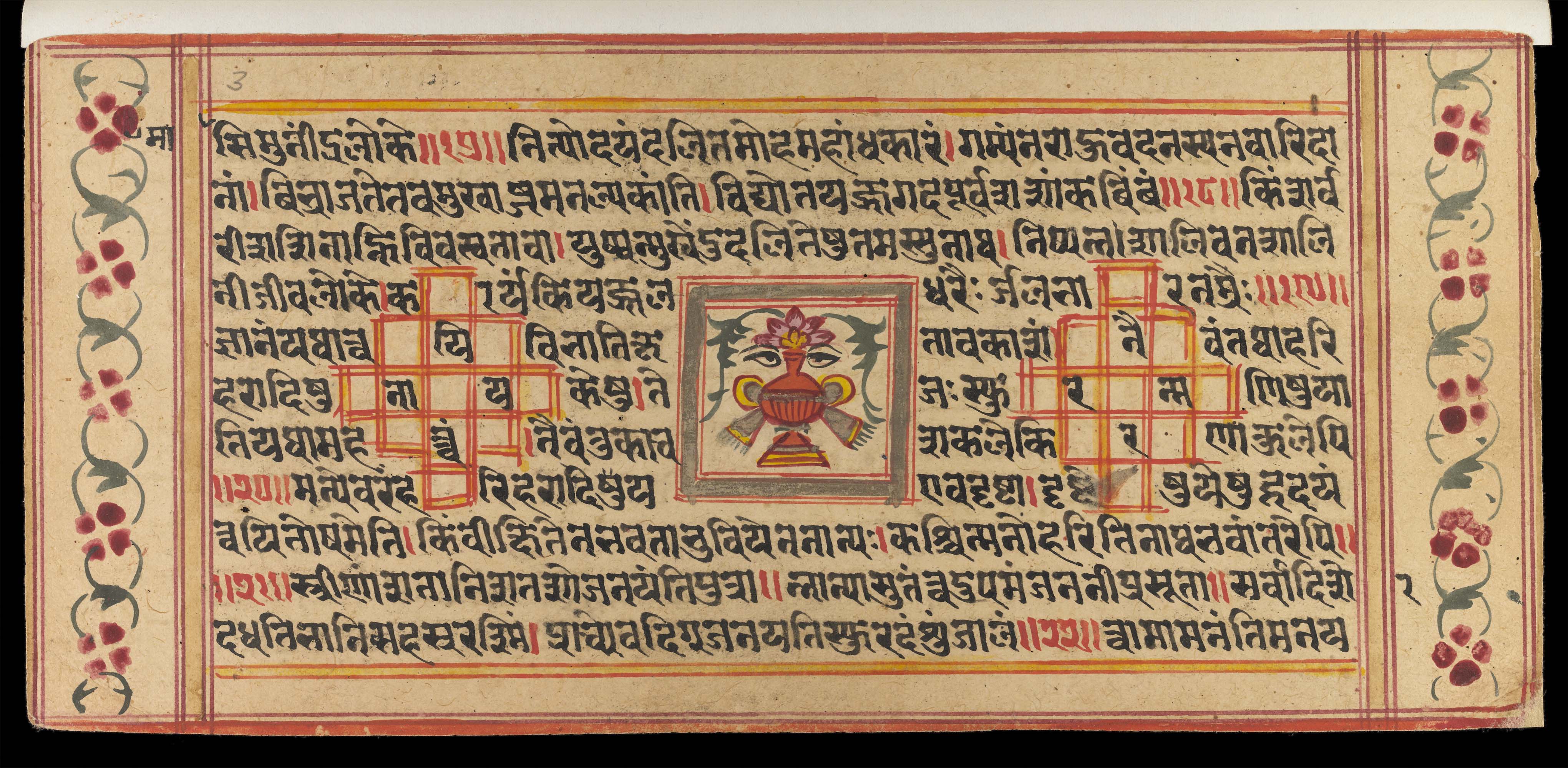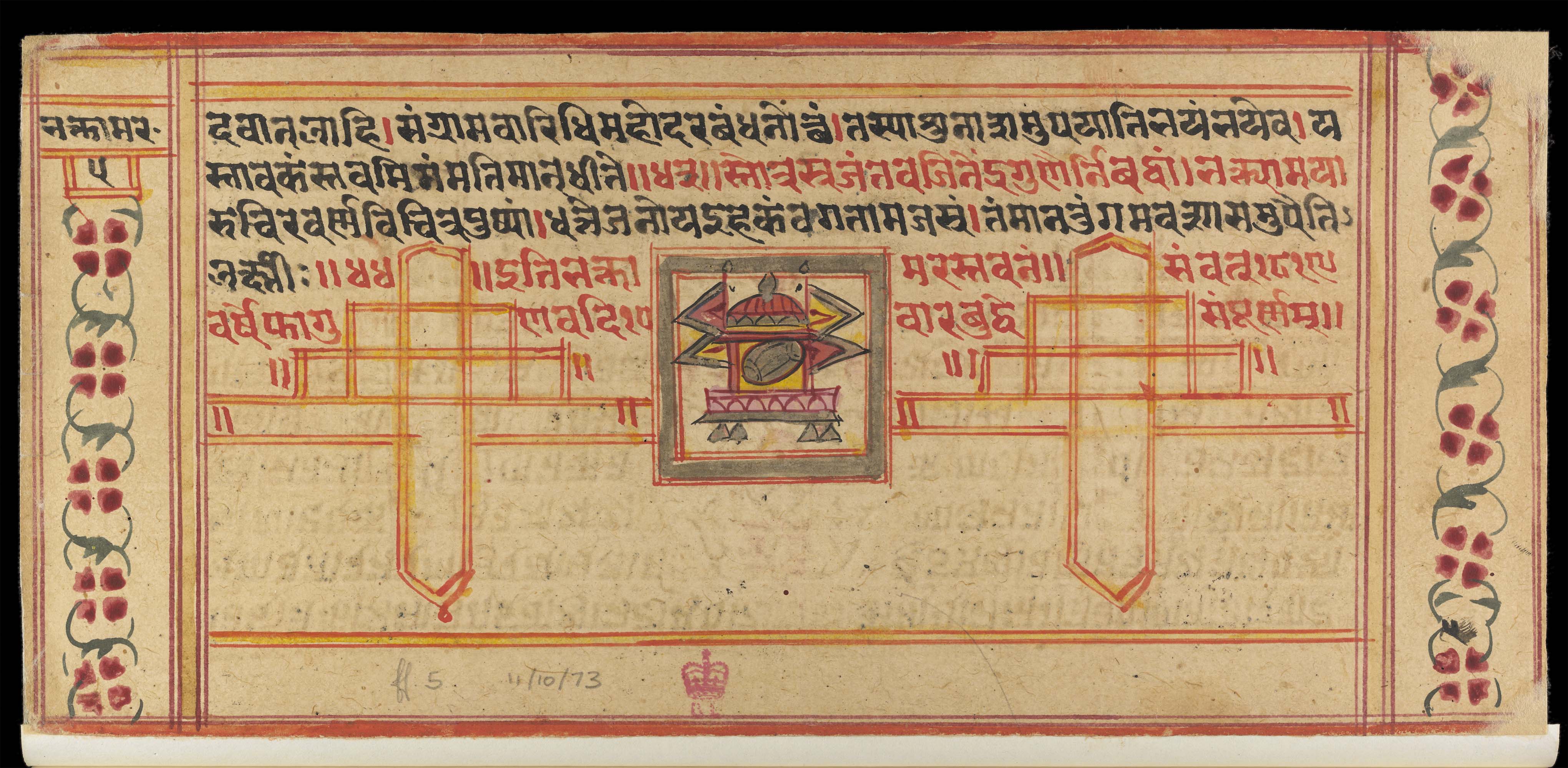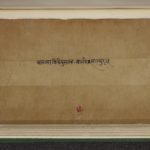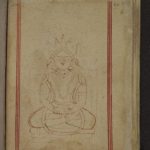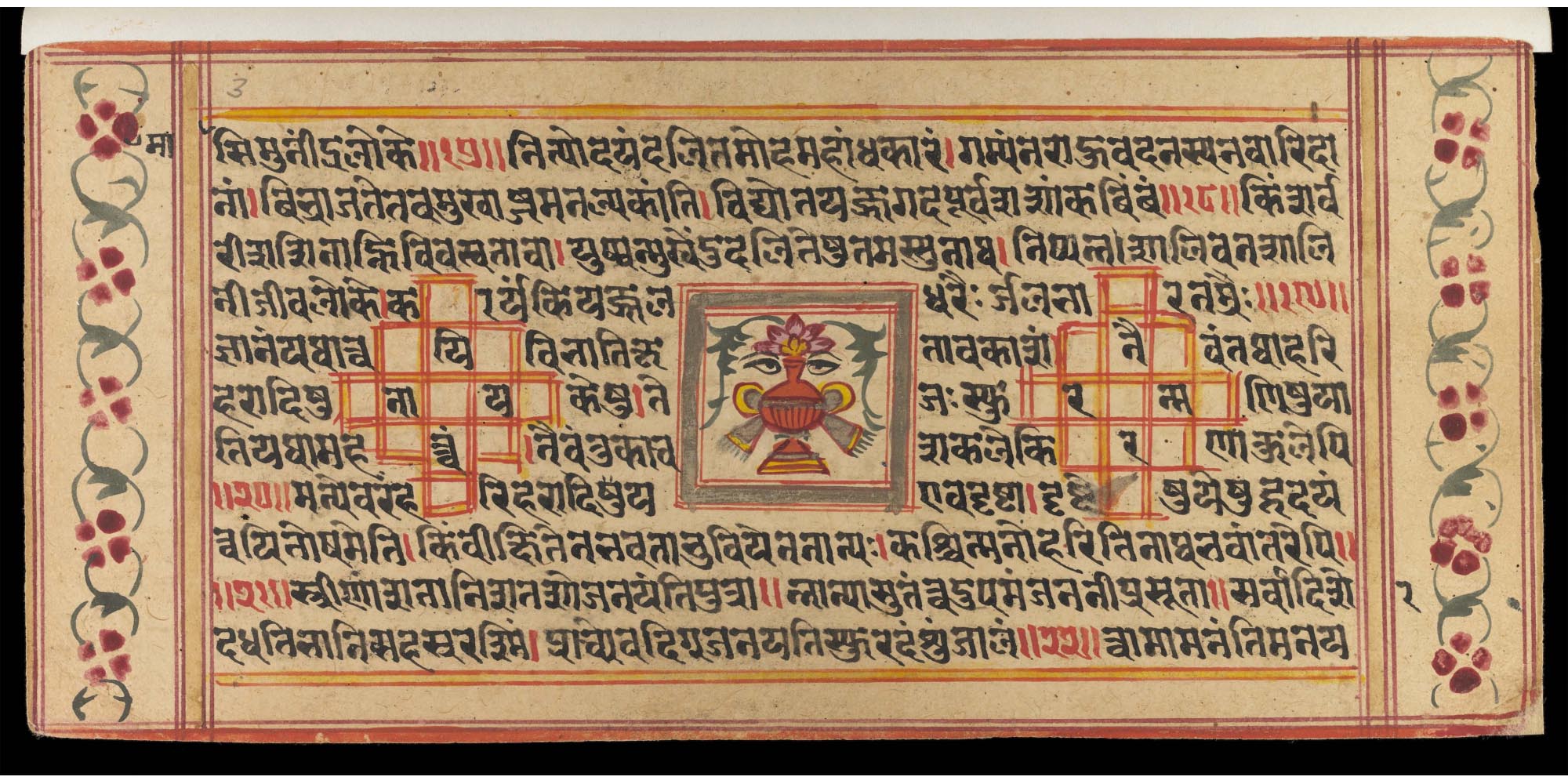
Background
One of the most popular devotional hymns of the Jain hymns is the Bhaktāmara-stotra – Devoted Gods Hymn. With either 44 or 48 stanzas, it is accepted by both main sects of Śvetāmbaras and Digambaras. It is dedicated to the first Jina, Ṛṣabhanātha or Lord Ṛṣabha, frequently known as Ādinātha, meaning ‘First Lord’. The title comes from the first verse, which says that 'his feet enhance the lustre of the jewels set in the crowns lowered by the devoted gods'.
The Bhaktāmara-stotra is written in Sanskrit in an elaborate poetical style. Many followers know the original text by heart and may daily recite or meditate upon it. This hymn of praise belongs to the categories of Sapta Smarans – 'Seven Remembrances' – or Nava Smarans – 'Nine Remembrances'. These refer to seven or nine popular hymns that form the core of Śvetāmbara Jain liturgy.
Mānatuṅga is the author of this hymn, and a figure who is the starting point of several legends. Recent scholarship considers that he was 'a Śvetāmbara devotional poet who lived in the second half of the 6th century A.D' (Wiley 2004: 53).
The Bhaktāmara-stotra has generated a number of commentaries from the 14th century onwards. It is also part of the Jain tantric tradition and is often given a magical value. Manuscripts of this text are often artefacts with noteworthy features. This manuscript demonstrates vignettes in the middle of each side of every folio, showing Jinas, auspicious symbols or mystical diagrams.
Transcription
1. [sūryâtiśāyi-mahi]*mâsi munîndra loke //17// nityôdayaṃ dalita-moha-mahâṃdha-kāraṃ / gamyaṃ na rāhu-vadanasya na vāridā-
2. nāṃ / vibhrājate tava mukhâbjam analpa-kāṃti / vidyotayaj jagad apūrva-śaśāṃka-biṃbaṃ // 18// kiṃ śarva-
3. rī* śaśinâhni vivasvatā vā / yuṣman-mukhêṃdu-daliteṣu tamassu nātha / niṣpanna*-śāli-vana-śāli-
4. nī* jīva-loke *kararyaṃ kāryaṃ kiyaj jaladharaiḥr jala-bhāra-namraiḥ //19//
5. jñānaṃ yathā tvayi vibhāti kr̥tâvakāśaṃ / naivaṃ tathā Hari-
6. Harâdiṣu nāyakeṣu / tejaḥ sphuran-maṇiṣu yā-
7. ti yathā mahattvaṃ / naivaṃ tu kāca-śakale kiraṇâkule ‘pi
8. //20// manye varaṃ Hari-Harâdaya* eva dr̥ṣṭā / dr̥ṣṭeṣu yeṣu hr̥dayaṃ
9. tvayi toṣam eti / kiṃ vīkṣitena bhavatā bhuvi ? yena nânyaḥ / kaścin mano *hariti nātha bhavâṃtare ‘pi //
10. //21// strīṇāṃ śatāni śataśo janayaṃti putrā //n nânyā sutaṃ tvad-upamaṃ jananī prasūtā // sarvā diśe*
11. dadhati bhāni sahasra-raśmiṃ / prācy eva dig janayati sphurad-aṃśu-jālaṃ //22 // tvām āmanaṃti *manaya[ḥ]
The asterisk symbol * indicates obvious scribal errors in this manuscript. There are several on this page, detailed in the table.
|
Line number |
Correction |
|---|---|
|
start of 1 |
The syllable mā had been omitted, and has been added in the margin, probably by a later user of the manuscript. |
|
end of 2, start of 3 |
śarvarī should be śarvarīṣu |
|
towards the end of 3 |
The scribe had written niṣpannā. Either he himself or the reader who corrected other mistakes realised that this was an error as the word should be niṣpanna. To indicate that the final a should be read as a short not long vowel, he has written a small stroke above the vertical bar of the long a in order to erase it. This is a common way of indicating errors relating to the quantity of vowels. |
|
end of 3, start of 4 |
śālinī should be śālini |
|
4 |
kararyaṃ should be kāryaṃ |
|
8 |
The scribe had first written Hariharādiṣu, then erased i and ṣu and wrote ya, resulting in the correct form Hariharādaya. |
|
9 |
hariti should be harati |
|
end of 10 |
The sign in the right-hand margin indicates that the last word in the line, written as diśe, should be read, correctly, as diśo. |
|
11 |
manaya[ḥ] should be munayaḥ |
Translation
1. [You surpass the sun in greatness] in this world, Lord of the Jinas //17// Having a perpetual rise, having destroyed the darkness of delusion, never within the reach of Rāhu or clouds,
2. your lotus-face shines, with considerable beauty – the disc of a moon without equal, illuminating the world // 18// What is the use
3. of a moon at night, of a sun in the day, when your moon-face has destroyed all darkness, O Lord? When the living world is full of
4. grown rice fields, how is there a need for; clouds loaded with water? //19//
5–6. Knowledge does not shine in the same way in leaders like Hari and Hara as it does having found space in you. The greatness that is found in sparkling jewels
7. cannot be found in a piece of glass, even if it is full of rays.
8. //20// It was good, I think, that I first saw Hari, Hara and others. As I have seen them [already], my heart
9. finds full satisfaction in you. What was the use of seeing you? – In the world no one else captivates the mind, O Lord, even in another birth.
10. //21// Hundreds of women give birth to hundreds of sons. No other had given birth to someone comparable to you. All directions
11. carry constellations. But only the eastern direction produces the sun with its collection of sparkling rays //22// Sages give you….
These verses of the hymn underline the ideas that:
- the Jina is characterised by beauty and brightness that are both unequalled and eternal
- the Jina is superior to Hindu gods
- this superiority is clear when comparing them and thus is rational
- the mothers of the Jinas are extremely important.
The Jina's unparalleled beauty and radiance are stressed throughout the hymn. A Jina is the luminary above all others, superior to even the best sources of light and brightness, such as the sun and the moon.
These verses emphasise that the Jina is superior to Hindu gods, here represented by Hari and Hara. These are Viṣṇu and Śiva, two members of the Hindu triad. Later stanzas add Brahmā, the third member of the Hindu triad, and Buddha among those whom the Jina surpasses.
The hymn presents this superiority as the result of a comparative experience. This underscores the rationality of the belief.
The last stanza on this page highlights the role of the mothers of Jinas, a feature otherwise expressed through the notion of the auspicious dreams, for instance. Queen Marudevī is not explicitly named here but is a particular focus in Jain religiosity because she is the mother of the first Jina.
Glossary
Description
Manuscripts of the Bhaktāmara-stotra are often artefacts with noteworthy aesthetic features, which underline the particular value and presence of this hymn in the Jain tradition. The song has magic powers and is part of the Jain tantric tradition, associated with mantras and yantras.
Each recto and verso page of this manuscript has a central vignette. All different from each other, they depict auspicious symbols or figures.
Here the painting is of the full jar – mangala-kalaśa – which means prosperity, and is one of the eight auspicious symbols – aṣṭa-mangala. From the top of the jar rises a pink lotus flower and creepers. In Jain art the full jar is mostly shown with two eyes at the sides. They have been interpreted as representations of clairvoyant knowledge, or may be ‘a vestigial representation of the sun which sees all and knows all’ (W. Norman Brown 1934, page 12, number 5).
On the left and right there are elaborate geometrical shapes containing syllables from the text. These shapes are not specific to Bhaktāmara-stotra manuscripts, being found widely in Jain manuscripts. Nevertheless, they indicate a concern for ornamentation.
Selected pages of this manuscript are digitised on JAINpedia.
Other visual elements
There are several notable things about this page.
- Verse numbers are at the end of each stanza and are often written between two vertical red lines, like here. Numbers '17' to '22' are visible here.
- The margins are decorated with an ornamental motif of flowers and leaves.
Script
The elaborate script is the Jaina Devanāgarī script, here written in a form which recalls calligraphy. It is used for writing numerous Indian languages, here for Sanskrit.
The red vertical lines – daṇḍas – within the text are used to divide the parts of a verse. Single ones mark the end of a pāda, a verse part. Double ones mark the end of the whole verse.
- Source:
The British Library Board
- Shelfmark:
Or. 13478
- Author:
Mānatunga
- Date of creation:
1762
- Folio number:
3 recto
- Total number of folios:
5
- Place of creation:
western India
- Language:
Sanskrit
- Medium:
paper
- Size:
25.5 x 11.5 cms
- Copyright:
CC0 1.0 (Creative Commons Public Domain)
- Image Copyright:
- +
- aAbhavya
- aAbhinandana
- aAbhiṣeka
- aĀcāra
- aĀcārāṅga-sūtra
- aĀcārya
- aAchalbhrata
- aAḍhāī-dvīpa
- aAdharma
- aAdho-loka
- aAdhyayana
- aAdvaita Vedānta
- aĀgama
- aAghātīya
- aAghātīya-karman
- aAgnibhuti
- aAgra
- aĀhāra
- aAhiṃsā
- aAhimsa Day
- aAjita
- aAjīva
- aAkampit
- aĀkāśa
- aAkbar the Great
- aAkṣaya-tṛtīyā
- aAlauddin Khalji
- aAlbert Einstein
- aAllah
- aAlms
- aĀlocanā
- aAloka-ākāśa
- aAmāri
- aAmbikā or Kūṣmāṇḍinī
- aAnagāra
- aAnanta
- aAnarthadaṇḍa
- aAnaśana
- aAnekānta-vāda
- aAṅga
- aAniconism
- aAnojjā
- aAntarāla
- aAntarāya-karma
- aAṇu
- aAṇu-vrata
- aAnukampā
- aAnuprekṣā
- aAnusvāra
- aApabhraṃśa
- aAparigraha
- aAra
- aĀrambha
- aĀrambhaja
- aĀratī
- aArdhamāgadhī Prākrit
- aArhaṃ
- aArhat
- aArśana-āvaraṇīya-karma
- aĀrta-dhyāna
- aĀryikā
- aĀryikā Jñānamati
- aĀśātanā
- aĀścarya
- aAscetic
- aAsceticism
- aAshram
- aAspiration
- aĀsrava
- aAṣṭa-maṅgala
- aAṣṭāpada
- aAstikāya
- aAstrolabe
- aAsura
- aAtheism
- aAticāra
- aAtiśayakṣetra
- aAtithisaṃvibhāgavrata
- aĀtma-vāda
- aĀtman
- aAuṃ
- aAurangzeb
- aAuspicious
- aAusterity
- aAvadhāna
- aAvadhi-jñāna
- aĀvaraṇī-yakarman
- aAvasarpiṇī
- aAvatāra
- aAvidyā
- aAxiom
- aĀyāga-paṭa
- aĀyambil
- aĀyu-karma
- aĀyurveda
- bBabur
- bBāhubali
- bBaladeva
- bBālāvabodha
- bBandha
- bBasadi
- bBazaar
- bBhadrankarvijay
- bBhagavant
- bBhaktāmara-stotra
- bBhakti
- bBhale
- bBharata
- bBhāṣā
- bBhāṣya
- bBhaṭṭāraka
- bBhāva
- bBhāva-pūjā
- bBhāvanā
- bBhavana-vāsin
- bBhavya
- bBhavyatva
- bBhaya
- bBhoga-bhūmi
- bBhogopabhoga
- bBodhi
- bBollywood
- bBrahmā
- bBrahma-deva
- bBrahmacārī
- bBrāhmaṇa
- bBraj Bhāṣā
- bBright fortnight
- bBritish Raj
- bBuddha
- bBuddhi-sagar
- bBuddhism
- bBuddhist
- cCaitya
- cCaityavāsin
- cCakravartin
- cCakreśvarī
- cCāmara
- cCandanā
- cCandragupta
- cCandraprabha
- cCanon
- cCāritra
- cCāritramohanīya-karman
- cCarũrī
- cCaste
- cCaturvidha-saṅgha
- cCaturviṃśati-stava
- cCāturyāma
- cCE
- cCelibacy
- cCha
- cChadmastha
- cChastity
- cCheda-sūtra
- cChristian
- cChristianity
- cClergy
- cCloning
- cColophon
- cCommentary
- cConch
- cConfession
- cCongregation
- cConsecration
- cCosmology
- cCremation
- cCrore
- cCult
- cCūrṇi
- dDādā-guru
- dDalit
- dDāna
- dDaṇḍa
- dDark fortnight
- dDarśana
- dDarśanamohanī-yakarman
- dDaśa-lakṣaṇa-parvan
- dDeity
- dDelhi Sultanate
- dDerāsar
- dDeśāvakāśika-vrata
- dDetachment
- dDevanāgarī
- dDevānandā
- dDevarddhi-gani
- dDevotee
- dDhamal
- dDhanuṣ
- dDhāra
- dDharma
- dDharma-dhyāna
- dDharma-sāgara
- dDharmastikaya
- dDhātakīkhaṇḍa
- dDholak
- dDhyāna
- dDiaspora
- dDig-vrata
- dDigambara
- dDīkṣā
- dDisciple
- dDīvālī
- dDivya-dhvani
- dDNA
- dDoctrine
- dDogma
- dDonor
- dDoṣa
- dDravya
- dDravya-pūjā
- dDrone
- dDuṣamā
- dDuṣamā-duṣamā
- dDuṣamā-suṣamā
- dDveṣa
- dDvīpa
- eEast India Company
- eEightfold Path
- eEkānta-vāda
- eEkendriya
- eElder
- eElders
- eEschatology
- eEtc up to
- fFarmān
- fFast
- fFatehpur Sikri
- fFestival
- fFestschrift
- fFiruz Shah
- fFly-Whisks
- fFolio
- fFour Noble Truths
- gGaccha
- gGaṇa
- gGaṇadhara
- gGanadharavada
- gGaṇeśa
- gGaṇin
- gGarba
- gGarbha
- gGarbha-gṛha
- gGaruḍa
- gGati
- gGene
- gGenomics
- gGhātī-yakarman
- gGhātīya
- gGhaznavid
- gGhiyasuddin Tughlaq
- gGhurid
- gGloss
- gGotra-karma
- gGujarāt
- gGujarati
- gGuṇa
- gGuṇa-sthāna
- gGuṇa-vrata
- gGupti
- gGuru
- gGuruṇī
- hHagiography
- hHajj
- hHaṃsa
- hHaribhadra
- hHariṇaigameṣin
- hHasta
- hHeresy
- hHiṃsā
- hHindi
- hHindu
- hHinduism
- hHīravijaya
- hHoroscope
- hHrīṃ
- hHumayun
- hHymn
- iIconoclasm
- iIconography
- iIdol
- iIndian Independence
- iIndology
- iIndra
- iIndrabhūti Gautama
- iIndriya
- iInitiation
- iIntercession
- iInvocation
- iIQ
- iIslam
- iIslamicate
- iIṣṭadevatā
- iĪśvara
- jJagat
- jJahangir
- jJain
- jJaina Devanāgarī
- jJaina Śaurasenī
- jJaina-dharma
- jJainaśāsana
- jJainness
- jJaisalmer
- jJamāli
- jJambū-dvīpa
- jJames Burgess
- jJanma
- jJanma-kalyāṇa
- jJarā
- jJāti
- jJina
- jJina-āgama
- jJina-bhavana
- jJina-bimba
- jJina-mātā
- jJinacandra-sūri
- jJinadatta
- jJinaprabha
- jJīva
- jJñāna
- jJñāna-āvaraṇīya-karma
- jJñāna-āvarṇiya
- jJñānsundar
- jJyotiṣka
- kKāla
- kKālakācārya-kathā
- kKālidāsa
- kKalpa-sūtra
- kKalpa-vṛkṣa
- kKalyāṇaka
- kKalyanvijay
- kKamaṇḍalu
- kKamaṭha
- kKarma
- kKarma-bhūmi
- kKarma-grantha
- kKarma-prakṛti
- kKarma-vāda
- kKarmon
- kKarnataka
- kKaṣāya
- kKathā
- kKāvya
- kKāya
- kKāyotsarga
- kKeśa-loca
- kKetu
- kKevala-jñāna
- kKevalin
- kKhalji
- kKharatara-gaccha
- kKnowledge
- kKriyā
- kKriyā-vāda
- kKṛṣṇa
- kKṣamā-śramaṇa
- kKṣapakaśreṇi
- kKṣatriya
- kKṣullaka
- kKulakara
- kKundakunda
- kKunthu
- lLabdhi
- lLaity
- lLakh
- lLāñchana
- lLands of Action
- lLaukāntika
- lLavaṇa-samudra
- lLeśyā
- lLiṅga
- lLinguistics
- lLoka
- lLoka-ākāśa
- lLoka-puruṣa
- lLoka-vāda
- lLotus
- lLotus lake
- mMadhya-loka
- mMahā-videha
- mMahā-vrata
- mMahābhārata
- mMahāmastakābhiṣeka
- mMāhārāṣṭra
- mMāhārāṣṭrī Prākrit
- mMahattarā Yākinī
- mMahāvīr Jayantī
- mMahāvīra
- mMakāra
- mMakkhali Gośāla
- mMalli
- mMāna-stambha
- mManaḥ-paryāya-jñāna
- mMaṇḍala
- mMaṇḍapa
- mMandit
- mMaṅgala
- mMantra
- mMantras
- mManuṣya-loka
- mMarāṭhī
- mMārgaṇā
- mMartyr
- mMarudevī
- mMaṭha
- mMati-jñāna
- mMauryaputra
- mMecca
- mMendicant lineage
- mMetarya
- mMiracle
- mMithyādṛṣṭi
- mMohandas Gandhi
- mMohanīya-karma
- mMokṣa
- mMonastic order
- mMonasticism
- mMonk
- mMonotheism
- mMosque
- mMount Meru
- mMount Sammeta
- mMṛgāvatī
- mMughal
- mMuhammad
- mMuhammad bin Tughlaq
- mMuhpattī
- mMūla-sūtra
- mMūlaguṇa
- mMumbaī
- mMuni
- mMunisuvrata
- mMurad Bakhsh
- mMūrti-pūjaka
- mMuslim
- mMysticism
- nNābhi
- nNāga-kal
- nNāgapurīya Tapā-gaccha
- nNāgarī
- nNāma-karma
- nNamaskāra-mantra
- nNami
- nNandīśvara-dvīpa
- nNandivardhana
- nNandyāvarta
- nNāraka
- nNāraki
- nNasalisation
- nNātha
- nNavrātrī
- nNaya-vāda
- nNemi
- nNidāna
- nniggaṃthāṇa vā 2
- nniggaṃtho vā 2
- nNigoda
- nNihnava
- nNikṣepa
- nNirgrantha
- nNirjarā
- nNirvāṇa
- nNiryukti
- nNiṣidhi
- nNitya
- nNiyati
- nNo-kaṣāya
- nNudity
- nNun
- oOcean of milk
- oOmniscience
- oOrdination
- ppa°
- pPadmaprabha
- pPadmāsana
- pPadmāvatī
- pPādukā
- pPalanquin
- pPalette
- pPañca-muṣṭi
- pPāṇḍava
- pPaṇḍit
- pPandit Dalsukh D. Malvania
- pPandit Sukhlalji
- pPāṇipātra
- pPāpa
- pParamātman
- pParameṣṭhin
- pPāraṇā
- pParigraha
- pPariṇāma
- pParīṣaha
- pParokṣa
- pPārśva
- pPārśvanātha
- pParyāya
- pParyuṣaṇ
- pPaṭa
- pPatan
- pPātra
- pPenance
- pPersian
- pPhala
- pPhilology
- pPicchikā
- pPilgrimage
- pPīr
- pPolymath
- pPoṣadha
- pPossession
- pPothī
- pPrabhas
- pPradakṣiṇā
- pPradeśa
- pPrākāra
- pPrakīrṇaka-sūtra
- pPrākrit
- pPramāda
- pPramukhā
- pPrati-vāsudeva
- pPratikramaṇa
- pPratimā
- pPratiṣṭhā
- pPratyākhyāna
- pPratyakṣa
- pPravacana
- pPrāyaścitta
- pPrayer
- pPre-modern
- pPreach
- pPredestination
- pProtestant
- pProvenance
- pPudgala
- pPūjā
- pPujārī
- pPukharavara-dvīpa
- pPuṇya
- pPūrva
- pPuṣkara-dvīpa
- pPuṣpadanta
- pPyre
- qQur’an
- rRāga
- rRāhu
- rRainy season
- rRajasthan
- rRajasthani
- rRājimatī
- rRajoharaṇa
- rRajput
- rRāma
- rRāmāyaṇa
- rRangoli
- rRās-garbā
- rRasa
- rRathanemi
- rRatna-traya
- rRātri-bhojana
- rRaudra-dhyāna
- rRecto
- rRelic
- rRenunciation
- rRetroflex
- rRevatī
- %Ṛg-veda
- rRite
- rRosary
- %Ṛṣabha
- %Ṛṣabhanātha
- rRupee
- sSaciyā Mātā
- sSādhu
- sSādhvī
- sSāgāra
- sSaint
- sŚaivaism
- sŚaka-saṃvat
- sSallekhanā
- sŚalya
- sSamacatuṣṭha
- sSamādhimaraṇa
- sSamaṇi
- sSāmarambha
- sSamavasaraṇa
- sSāmāyika
- sSaṃbhava
- sSamiti
- sSaṃjñā
- sSaṃkalpaja
- sSaṃsāra
- sSamudghāta
- sSaṃvara
- sSaṃvega
- sSamyak-cāritra
- sSamyak-darśana
- sSamyak-jñāna
- sSamyaktva
- sSaṃyama
- sSanctuary
- sSandalwood
- sSaṇgha
- sSanskrit
- sSant
- sŚānti
- sSapta-bhaṅgi-naya
- sSārambha
- sSarasvatī
- sSarvajña
- sSāsan-devi
- sŚāsana-devatā
- sŚāstra
- %Ṣaṭ-jīvanikāya
- sSatī
- sSatīmātā
- sSatya
- sSchism
- sScribe
- sScripture
- sSect
- sSecularism
- sŚenāī
- sSermon
- sŚeṣavatī
- sSevā
- sSeven fields of donation
- sShah Jahan
- sShantidas Jhaveri
- sShrine
- sSiddha
- sSiddha-śilā
- sSiddhacakra or Navadevatā
- sSiddhānta
- sSiddhārtha
- sSiddhi
- sSikh
- sSikhism
- sŚikṣā-vrata
- sŚīla
- sSin
- sSindh
- sŚītala
- sŚiva
- sSkandha
- sSomanatha
- sŚraddhā
- sŚramaṇa
- sŚrāvaka
- sŚrāvakācāra
- sŚrāvikā
- sŚreyāṃsa
- sŚrī
- sŚrīvatsa
- sŚruta-jñāna
- sŚruta-pañcamī
- sSthānaka-vāsin
- sSthāpanācārya
- sSthāvara
- sSthavira
- sSthiti
- sStrīmukti
- sStūpa
- sSubcontinent
- sSudarshana
- sŚuddhi
- sSudharma
- sŚūdra
- sSufism
- sSukha
- sŚukla-dhyāna
- sSulasā
- sSultan
- sSumati
- sSundarśrī
- sSupārśva
- sSūri
- sSuṣamā
- sSuṣamā-duṣamā
- sSuṣamā-suṣamā
- sSūtra
- sSuyam me ausam! Tenam bhagavaya evamakkhayam
- sSvādhyāya
- sSvāhā
- sSvastika
- sŚvetāmbara
- sŚvetāmbara Terāpanthin
- sŚvetāmbaras
- sSwan
- sSyād-vāda
- tTabla
- tTantra
- tTapā-gaccha
- tTapas
- tTāraṇ Svāmī Panth
- tTattva
- tTattvārtha-sūtra
- tTemple
- tTemple-city
- tThe Enlightenment
- tTheology
- tThree worlds
- %Ṭīkā
- tTilaka
- tTīrtha
- tTīrthaṃkaranāma-karman
- tTīrthankara
- tTransliteration
- tTrasa
- tTrasa-nāḍī
- tTriśalā
- tTriṣaṣṭi-śalākā-puruṣa-caritra
- tTti bemi
- tTughlaq
- tTunk
- uUdumbara
- uUniversal History
- uUpādhyāya
- uUpāṅga
- uUpaniṣads
- uUpāsaka
- uUpasarga
- uUpāśraya
- uŪrdhva-loka
- uUtsarpiṇī
- uUttarādhyayana-sūtra
- vVāhana
- vVaimānika
- vVairāgya
- vVaiṣṇava
- vVaiśramaṇa
- vVaiśya
- vValabhī
- vVanaspatikāya
- vVandana
- vVaṇik
- vVarṇa
- vVāsudeva
- vVāsupūjya
- vVayubhūti
- vVeda
- vVedanīya-karma
- vVegetarianism
- vVehicle
- vVernacular
- vVerso
- vVidyā
- vVidyā-devī
- vVihāra
- vVijñapti-patra
- vVikrama-saṃvat
- vVikṛti
- vVimala
- vVinaya
- vVipāka
- vVirji Vora
- vVirodhaja
- vVīrya
- vVisarga
- vViṣṇu
- vVītarāga
- vVizier
- vVotive
- vVow
- vVrata
- vVS
- vVyakta
- vVyantara
- vVyasana
- yYakṣa
- yYakṣī
- yYantra
- yYaśoda
- yYaśovijaya
- yYati
- yYātrā
- yYoga
- yYoginī
- yYojana
Description
Manuscripts of the Bhaktāmara-stotra are often artefacts with noteworthy aesthetic features, which underline the particular value and presence of this hymn in the Jain tradition. The song has magic powers and is part of the Jain tantric tradition, associated with mantras and yantras.
Each recto and verso page of this manuscript has a central vignette. All different from each other, they depict auspicious symbols or figures.
Here the painting is of the full jar – mangala-kalaśa – which means prosperity, and is one of the eight auspicious symbols – aṣṭa-mangala. From the top of the jar rises a pink lotus flower and creepers. In Jain art the full jar is mostly shown with two eyes at the sides. They have been interpreted as representations of clairvoyant knowledge, or may be ‘a vestigial representation of the sun which sees all and knows all’ (W. Norman Brown 1934, page 12, number 5).
On the left and right there are elaborate geometrical shapes containing syllables from the text. These shapes are not specific to Bhaktāmara-stotra manuscripts, being found widely in Jain manuscripts. Nevertheless, they indicate a concern for ornamentation.
Selected pages of this manuscript are digitised on JAINpedia.
Other visual elements
There are several notable things about this page.
- Verse numbers are at the end of each stanza and are often written between two vertical red lines, like here. Numbers ’17’ to ’22’ are visible here.
- The margins are decorated with an ornamental motif of flowers and leaves.
Script
The elaborate script is the Jaina Devanāgarī script, here written in a form which recalls calligraphy. It is used for writing numerous Indian languages, here for Sanskrit.
The red vertical lines – daṇḍas – within the text are used to divide the parts of a verse. Single ones mark the end of a pāda, a verse part. Double ones mark the end of the whole verse.





























































































